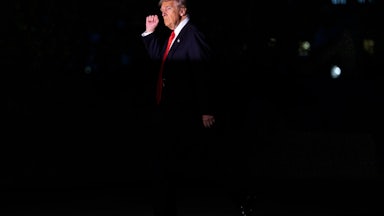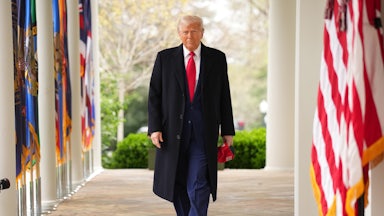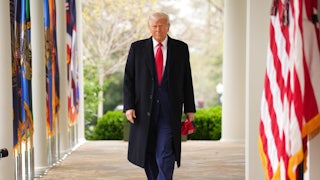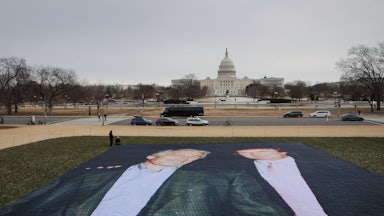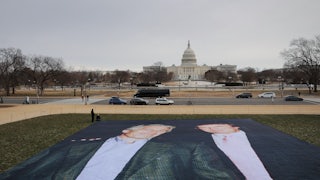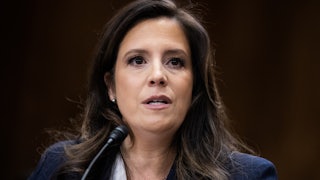When President Donald Trump addressed Army troops June 10 at Fort Bragg, his audience was screened for political leanings and physical appearance. “No fat soldiers,” read one unit-level message, according to Konstantin Toropin and Steve Beynon of Military.com. Another memo, reported by the NBC affiliate in Raleigh, said, “Soldiers sitting in the bleachers are to be fit and not look fat.” It’s inconceivable that these directives originated anywhere but the White House.
This presidential aversion isn’t new. “Trump has a long record, which he lengthens every day, of disparaging people for what he regards as excess pounds,” the Chicago Tribune columnist Steve Chapman noted in October 2016. But fat shaming is more than one of Trump’s many deeply offensive habits. It’s also a metaphor that Trump misapplies to the federal government he’s supposed to manage.
“Mr. Trump doesn’t like fat people,” a Trump Organization vice president once told a caterer at his golf club in Rancho Palos Verdes, California. When Trump owned the Miss Universe Organization, he humiliated one winner by publicly calling her “an eating machine” and, unbeknownst to her, invited the press to watch her work out at a gym. Trump said that Rosie O’Donnell had a “fat, ugly face” (he also called her a “pig”) and that Kim Kardashian had a “fat ass” (he also said she had a “bad body”).
These comments reflect Trump’s well-documented mistreatment of women, but Trump often insults men for their weight too. When Trump was a real estate developer he routinely referred to one New York City official behind his back as “the fat fuck,” according to a former Trump Organization executive. During the 2016 campaign he repeatedly mocked his opponent Chris Christie for his weight, once pointing to Christie and saying, “You’re not eating Oreos anymore. No more Oreos.” In August 2024, Trump said of the Democratic Montana Senator Jon Tester (who lost that year): “He’s got the biggest stomach I’ve ever seen.” Trump even mocked one of his own supporters at an August 2019 rally, saying, “That guy’s got a serious weight problem. Go home, start exercising!”
These are all textbook examples of what psychologists call narcissistic projection. Trump is a crook (a convicted felon, in fact), so he calls other people crooks. He’s a liar (The Washington Post counted more than 30,000 whoppers during his first term alone), so he calls other people liars (even a Gold Star widow!). He’s an ignoramus so he calls other people stupid. Trump’s obsession with other people’s weight is another manifestation: He’s an overweight man who calls other people (less politely) overweight.
According to the White House physician, Trump is six foot, three inches tall and weighs 224 pounds. Assuming that’s true (lots of people think it’s a lowball), Trump’s body mass index is 28. That makes Trump officially overweight. Two years into his first term Trump was 19 pounds heavier and therefore more than overweight: With a BMI of 30.4, he was officially obese. (According to the BMI height-weight scale, 30 or higher is obese.)
For those keeping score, that 2019 reading established Trump as the sixth-most-overweight president in American history. Only five of his predecessors exceeded the BMI obesity threshold: William Howard Taft (42.3), Grover Cleveland (34.6), William McKinley (31.1), Zachary Taylor, (30.2), and Theodore Roosevelt (30.2). Back in 2011, I wondered whether weight was a legitimate presidential campaign issue for Christie, so I matched the (then) five obese presidents against Arthur Schlesinger’s 1996 “greatness” rankings. That showed obesity was, “if anything, a slight presidential plus, with Zachary Taylor pulling the ranking down, Theodore Roosevelt pushing it back up, and Grover Cleveland and William McKinley nudging it a little higher.”
Admittedly, the smallness of the sample size made these findings highly tentative, and Trump’s inclusion surely puts the whole cohort underwater because Trump is indisputably the worst president in U.S. history. (Even many Republicans of my acquaintance think so.) As a borderline-obese person myself (28.9), I can’t help resenting that Trump weighted down a previously favorable statesmanship ranking.
Now let’s consider Trump’s use of body weight as a metaphor. During a February Cabinet-meeting photo op, Trump said: “This country has gotten bloated, fat, and disgusting.” Critics identified this correctly as another instance of narcissistic projection. But it was also something more.
Trump was talking about the federal workforce. The federal workforce was not, in fact, bloated, fat, and disgusting when Trump arrived in Washington, and it certainly isn’t now. The feds employ about two million civilians. How many civilians did they employ in 1953? About two million. How many in 1963? About two million. How many in 1973? About two million. How many in 1983? About two million.
What about Ronald Reagan? The Gipper shrank government, right? Wrong. Federal employment grew during Reagan’s presidency by about 80,000, which makes it weirdly appropriate that the biggest federal office building in Washington is named after him. President Bill Clinton did shrink civilian employment a bit, but only to a little less than two million. President Barack Obama increased it a bit, but only to a little more than two million.
Since 1953, the U.S. population has more than doubled, so the number of civilian federal employees available to serve each of us has shrunk more than one half. I’m not saying we should double civilian federal employment to about four million, because automation has reduced some of the need for federal workers. But only some of it. We certainly can’t get by easily (and haven’t in recent years) with only two million, especially if we’re to reduce our overreliance on government contractors (whose employees are more expensive than federal workers and often less accountable).
Yet Russell Vought, director of the White House Office of Management and Budget (and Elon Musk’s DOGE puppetmaster), has sold Trump on the idea that the federal workforce is bloated, fat, and disgusting. Accordingly, the House on Thursday approved funding cuts that would codify DOGE’s decimation of the U.S. Agency for International Development (an $8.3 billion cut) and the Corporation for Public Broadcasting (a $1.1 billion cut). Overall, DOGE has eliminated perhaps 12 percent of the federal workforce, though it’s hard to know how many of those firings and buyouts will stick because several federal agencies have reversed them, including the IRS, the Food and Drug Administration, and—surprise, surprise—USAID.
Like any large organization, the federal government isn’t always efficient, and making individual parts work better is always a worthwhile goal. But in the aggregate, our civil service is, if anything, understaffed, and it’s become considerably more so under Trump. The only bloat I see is in the deficit doubling that Trump’s Big, Beautiful Bill will achieve thanks to Trump’s tax cuts—and in Trump’s own growing net worth as he explores ever-more-blatant opportunities to violate the Constitution’s emoluments clause.
At that Fort Bragg appearance, Trump didn’t just exclude soldiers who “look fat.” He also sold Make America Great Again swag, in obvious violation of military rules and possibly also the law. Trump declaring the federal government bloated even as he uses his own government job to enrich himself—that’s narcissistic projection too.

